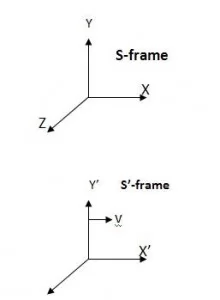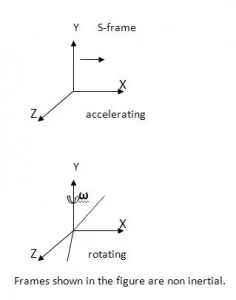Make physics as simple as possible but not simpler”- Albert Einstein
In 1905 Albert Einstein published a paper with a title “On the electrodynamics of moving bodies”. This work of Einstein gave a totally different notion of Physical world. It changed the foundation of physics and also our understanding of nature.
In the following we briefly discuss the fundamental concepts of this theory.
Frame of reference: A place from where observation is made is called frame of reference. In physics a frame of reference is represented by a co-ordinate system with respect to which spatial co-ordinate of any point in space is determined.

Frames of reference are of two types:
(1) Inertial frame of reference: Two frames are said to be inertial if they are at rest or moving with constant velocity w.r.t each other.

In figure shown S’ is moving with constant speed v w.r.t S. Therefore Sand S’ are inertial frames.
Non inertial frame of reference: A frame of reference is said to be non- inertial if it is either accelerating or rotating.

Postulates of STR:
STR deals with the inertial frames of reference and it is based on the following two postulates.
First Postulate: “All inertial frames are equivalent”. Therefore laws of physics must be invariant in all inertial frame frames. What this postulate implies is that, if an experiment is done in a laboratory and the same experiment is repeated in a van moving with constant velocity then result of experiment in the two cases will be same.
Second postulate: “Speed of light in vacuum has same value in all inertial frame and speed of light is the ultimate speed in vacuum”. What this postulate implies that,
• Speed of any object or anything cannot be greater than speed of light in vacuum.
• Magnitude of velocity of light is same in all inertial frames, but components of velocity of light changes. If velocity of photon w.r.t to S frame is v=c then velocity of photon w.r.t S’ frame is v’=c (i.e. same as in S frame).
• Velocity of any object (for example electron) can be greater than speed of light in

